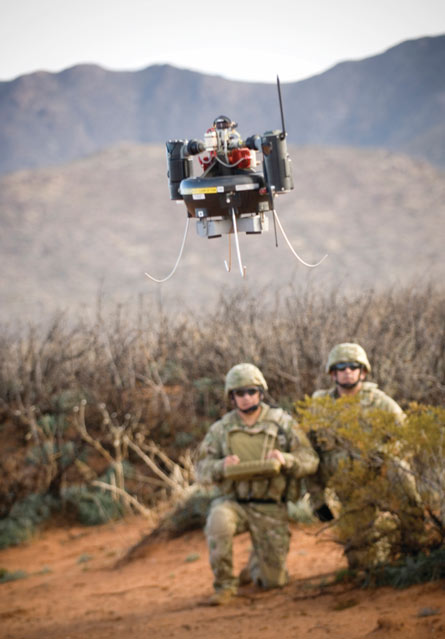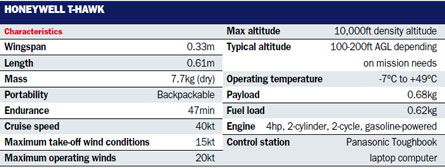Honeywell is working on evolutionary upgrades and next-generation advances for its gasoline-powered T-Hawk micro air vehicle (MAV) as military and para-public operators gain experience with the autonomous electro-optical and infrared sensor-carrying hover and stare platforms.
Included are methods of remotely launching the T-Hawk, running heavy fuel and building new integrated and broader-ranging sensors.
With almost 12,000 flights completed in both test and operational scenarios by hundreds of vehicles since the first ducted fan MAV prototypes took to the air in 2003 funded by a DARPA contract, operators are getting more comfortable and expanding the applications for the 46min endurance ducted fan.
According to Honeywell, the US military is using the Class 1 T-Hawk in Iraq and Afghanistan for surveillance and route clearance, flying ahead of convoys or ground units to detect improvised explosive devices or in a force protection role to remove the element of surprise.
 |
|---|
The US military is using the Class 1 T-Hawk for surveillance and route clearance |
The company is also developing a much larger Class 2 MAV for the Army's Brigade Combat Team Modernization (BCTM) Increment 2, with a first flight planned for 2012.
THINKING PROCESS
"There's a two- or three-step thinking process that goes on before [operators] can figure out how best to use the T-Hawk," says Vaughn Fulton, senior unmanned aerial systems programme manager for Honeywell. "Once the 'Ah-hah!' moment occurs, then they're constantly using it."
Each T-Hawk "system" includes two air vehicles, a ground support station and a control station - a Panasonic Toughbook laptop computer. The 8.4kg (18.5lb) air vehicle has a centre body duct with a two-cylinder, two-stroke, fuel-injected 4hp (3kW) gasoline engine powering a five-bladed fan that spins at around 7,000RPM in hover flight, blowing air through a stator and gimballed reaction control system.
Attached to the centre body is the avionics pod on one side and the payload pod, with detachable electro-optical and infrared cameras. The portable ground control station, with radios for video and command and control, plugs into laptop computer.
Operators use a stylus and soft pad on screen to move the air vehicle. "You point the camera where you want it," says Fulton. "The vehicle itself running autonomous flight controls with the pilot not directly coupled to the control surfaces - 99.9% of the deployment methodology is flying from the sensor."
The T-Hawk has more than two years of operations in Iraq and has been through two "block" iterations and a variety of software upgrades to suit operators. The Block 2 air vehicles carry a gimballed camera as opposed to the fixed camera in the Block 1, and the Block 3 has the army's digital datalink (DDL) installed, the fifth radio system installed in the T-Hawk for the various services since its introduction.
Fulton says the "hover and stare" capability of the T-Hawk provides "a bunch of mission advantages" over of fixed wing unmanned air vehicles, although working out the nonlinear operations made possible by a MAV can take "two or three flights". Fulton says the T-Hawk is being used "constantly" for route clearance operations in theatre.
LACK OF STEALTH
Army officials do not appear to be overly concerned with the T-Hawk's lack of stealth as a result of its operating noise (some describe it as a very loud high-pitched whine). "It may not matter that it's loud," says Col Greg Gonzalez, the army's programme manager for unmanned aircraft. "If it meets the niche capability for our forces, we will continue to refine it."
In the para-public domain, Florida's Miami-Dade County police department has been testing two T-Hawks since 2008 to determine how the MAV can help with surveillance during special operations.
The tests are also a proving ground of sorts with the US Federal Aviation Administration for how UAVs can be integrated with manned aircraft in civil airspace. Honeywell is researching whether Mode S transponders (that relay GPS position, altitude and other information), which typically weigh more than 2.2kg, could be miniaturised for the T-Hawk for air traffic control surveillance capabilities. To date, the company has developed a prototype Mode 4 beacon weighing 0.23kg that reports an aircraft's position but not its altitude.
Fulton says the US Fish and Wildlife Service (USFS) is considering testing the T-Hawk with infrared cameras in the national wildlife refuges along the US-Mexico border. In addition to illegal drug production and methamphetamine labs, Fulton says the area has "heavily armed people with fully automatic weapons" that end up in conflict with the USFS. "At the top level, it's a very similar mission profile to what we're running in Iraq," Fulton adds.
The service is focusing on three primary upgrades to the current fleet, based on mission feedback: a T-Hawk that flies on heavy fuel; a T-Hawk that can be started and launched from within an armoured vehicle, and an expanded sensor suite.
Fulton says today's T-Hawk can fly with heavy fuel, but only if the engine is warm. The company is considering several prototypes and will begin flight-testing the best candidate early next year. One solution is similar to a "cigarette lighter plug" that will contain a small supply of aviation gas for starting and warming the engine.
"Once it spins the engine up, it goes from little cylinder to the normal fuel load," says Fulton. Trade-offs include whether to require the operator to switch out the starting charge or allow the vehicle to discharge the canister or perhaps carry the extra weight.
The 18kg BCTM Increment 2 "objective" MAV that Honeywell is developing with Swift Engineering will have a 15hp heavy fuel engine that will operate in a wider temperature environment. Honeywell says it is likely to offer the airframe again at a later date, opening the possibility that the T-Hawk airframe builder, Textron Systems subsidiary, AAI, could bid.
EXTERNAL MOUNT SYSTEM
Fulton says Honeywell is targeting early 2011 for field trials of an external mount system for launching the T-Hawk, a system that would decrease operator exposure. "For the first iteration of T-Hawk, you had to step out, start the MAV to warm it up, put it on ground, go back to operating station, then go back to launch, exposing yourself twice," says Fulton.
For the Block 2 and Block 3 iteration, Honeywell decreased the exposure to once per launch by moving to a fuel injected engine thereby removing the warm-up step. "Now, they want an external mount of some kind that can be used to start up the bird and launch from a stationary vehicle," says Fulton. Fuel injection was retofitted to Block 1 T-Hawks.

For sensors, Honeywell is working on a new integrated EO and IR sensor head that would eliminate the need to physically switch out the units, as now required. "The advantage is that even in daylight, IR cameras let you see things that EO would not let you see," says Fulton.
Operators are also asking for a broader suite of sensing capabilities, in some cases allowing operators to fly "very low and slow" - 25-50ft (7.6-15.2m) above the ground - rather than the typical 100-200ft, says Fulton, adding that the current IR sensor is optimised for a slant range of 328ft or lower and the EO for 820ft or lower. "They need a tight narrow field of view so they can see things like detonation wires that show where an IED is placed."
Next year Honeywell also plans to begin investigating chemical/biological "sniffers" for the sensor package for military applications.
Source: Flight International























